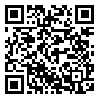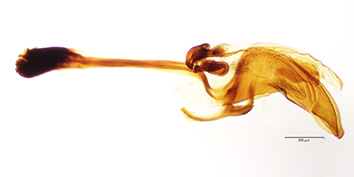Volume 7, Issue 4 (2021)
J. Insect Biodivers. Syst 2021, 7(4): 467-476 |
Back to browse issues page
Download citation:
BibTeX | RIS | EndNote | Medlars | ProCite | Reference Manager | RefWorks
Send citation to:



BibTeX | RIS | EndNote | Medlars | ProCite | Reference Manager | RefWorks
Send citation to:
Alichi M, Minaei K. Dynamics of a cooperative lock-and-key model in genital matching of Sitona Germar (Coleoptera: Curculionidae). J. Insect Biodivers. Syst 2021; 7 (4) :467-476
URL: http://jibs.modares.ac.ir/article-36-55426-en.html
URL: http://jibs.modares.ac.ir/article-36-55426-en.html
1- Department of Plant Protection, School of Agriculture, Shiraz University, Shiraz, Iran.
2- Department of Plant Protection, School of Agriculture, Shiraz University, Shiraz, Iran , kminaei@shirazu.ac.ir
2- Department of Plant Protection, School of Agriculture, Shiraz University, Shiraz, Iran , kminaei@shirazu.ac.ir
Abstract: (2647 Views)
It has been argued that the copulatory structures of the weevil genus Sitona Germar have their equivalents in the opposite sex. Hence, the male intromittent organ represents a species-specific key to unlock the corresponding genital tract of its mate, and the female internal genitalia displays several positions that match the functional armature and surface prominences of the endophallic internal sac from the conspecific male. However, this claim can lead to a major challenge due to the perceived lack of variation in the females copulatory organs across the species of a large genus, Sitona. Therefore, a special case can be very helpful for modeling an elaborate correspondence of male and female genital traits in this group. One of the most intricating and unusual forms of the genitalia in the tribe Sitonini that is assumed to be the representative of an advanced type of the “lock-and-key” relationship belongs to S. fairmairei. A pair of peculiar “bursal plugs” along with the two slender accessory pouches were revealed inside the female bursal lumen of this species that were considered to operate in concert with the unusual ejaculatory pump and anchoring device of the male transfer apparatus respectively, in the process of insemination. The Modification of the pumping device and the way that the endophallic armature threads along the female spermathecal duct in S. fairmairei were compared to another species, S. cylindricollis. Our results provide evidence on how the biomechanics of copulation can drive the evolution of a “cooperative lock-and-key” isolating mechanism in the genital traits of the weevil genus Sitona, as well as the significance of a clear understanding about the reciprocal morphologies of male and female copulatory organs.
Keywords: Bio-syringe , Evolutionary trend , Genital coupling , Lock-and-key , Sitonini , Sperm pump , Transfer apparatus
Article Type: Research Article |
Subject:
Systematics/Coleoptera
Received: 2021/09/8 | Accepted: 2021/11/10 | Published: 2021/11/14
Received: 2021/09/8 | Accepted: 2021/11/10 | Published: 2021/11/14
References
1. Alichi, M. (2021) A bio-syringe mechanism and the pattern of genital correspondence in the weevil genus Sitona (Coleoptera: Curculionidae): an approach to the great interest of Sharp and Muir. Zootaxa, 4933 (4), 514–526. [https://doi.org/10.11646/zootaxa.4933.4.3]
2. Alichi, M. & Ahmadi, A.A. (1993) The Sitona species (Coleoptera: Curculionidae) of Fars Province. Journal of Entomological Society of Iran, 12 & 13, 73–85.
3. Aslam, N.A. (1961) An assessment of some internal characters in the higher classification of the Curculionidae s.1. (Coleoptera). Transactions Royal Entomological Society of London, 113, 417–418. [https://doi.org/10.1111/j.1365-2311.1961.tb00799.x]
4. De Wilde J. (1964) “Reproduction”. In: Rockstein M, (ed.) Physiology of Insecta. Academic Press, New York, USA, pp. 9–58.
5. Dufour, L. (1844) Anatomie generale des dipteres. Annales des Sciences Naturelles, 1, 244–264.
6. Eberhard, W.G. (1985) Sexual Selection and Animal Genitalia. Harvard University Press, Cambridge, Mass, USA.
7. Gaiger, F. & Vanin, S.A. (2008) On the utility of female genitalia in the systematics of Curculionidae: examples from Entimini and Hylobiina (Coleoptera: Curculionidae). Annales of the Société Entomologique de France, 44 (1), 47–57. [https://doi.org/10.1080/00379271.2008.10697543]
8. Garthe, W.A. (1969) Development of the female reproductive system and effect of males oenocyte production in Sitona cylindricollis (Coleoptera: Curculionidae). Annals of the Entomological Society of America, 63, 367–370. [https://doi.org/10.1093/AESA/63.2.367]
9. Goldson, S.L. & Emberson, R.M. (1981) Reproductive morphology of the Argentine stem weevil, Hyperodes bonariensis (Coleoptera: Curculionidae). New Zealand journal of Zoology, 8, 67–77. [https://doi.org/10.1080/03014223.1981.10427942]
10. Gültekin, L., Velazquez de Castro, A.J. & Gültekin, N. (2019) Morphological diagnosis of Charagmus variegatus (Fåhraeus, 1840) (Coleoptera: Curculionidae) with new distributional data. Transactions of the American Entomological Society, 145 (1), 67–74. [https://doi.org/10.3157/061.145.0107]
11. Johnson, N.A., Lahti, D.C. & Blumstein, D.T. (2012) Combating the Assumption of Evolutionary Progress: Lessons from the Decay and Loss of Traits. Evolution: Education and Outreach, 5, 128–138. [https://doi.org/10.1007/s12052-011-0381-y]
12. Kasap, H. & Crowson, R.A.F. (1980) The female reproductive organs of Bruchidae and Chrysomelidae (Coleoptera). Türkiye Bitki Koruma Dergisi, 4, 85–102.
13. Kelly, D.A., & Moore, B.C. (2016) The Morphological Diversity of Intromittent Organs. Integrative and Comparative Biology, 56 (4), 630-634. [https://doi.org/10.1093/icb/icw103]
14. Kevan, D.K. (1960) The British species of the genus Sitona Germar (Col. Curculionidae). Entomologist’s Monthly Magazine, 95, 251–261.
15. Kullenberg, B. (1947) Der Kopulationsapparat der Insekten aus phylogenetischem Gesichtspunkt. Zoologiska bidrag fran Uppsala, 147, 79–90.
16. Lawrence, J.F. & Britton, E.B. (1991) Coleoptera (Beetles). In: Naumann, I. (ed.) The Insects of Australia. A textbook for students and research workers. Melbourne, University (CSIRO), Melbourne. pp. 543–683.
17. Lindroth, D.H. & Palmen, T.H. (1970) Coleoptera. In: Tuxen, S.L. (ed.) Taxonomist’s Glossary of Genitalia in Insects. Scandinavian University Munksgaard, Copenhagen, Denmark. pp. 80–88.
18. Mikkola, K. (2008) The lock-and-key mechanisms of the internal genitalia of the Noctuidae (Lepidoptera): How are they selected for? European Journal of Entomology, 105 (1), 13–25. [https://doi.org/10.14411/eje.2008.002]
19. Porter, M.L. & Crandall, K.A. (2003) Lost along the way: The significance of evolution in reverse. Trends in Ecology and Evolution, 18 (10), 541–547. [https://doi.org/10.1016/S0169-5347(03)00244-1]
20. Rentz, D. (1972) The lock and key as an isolating mechanism in katydids. American Scientist, 60, 750–755.
21. Sert, O. (2006) On the female and male genital structures of Sitona fairmairei Allard, 1869 (Coleoptera: Curculionidae) from Turkey. Entomological News, 117, 441–443.
22. Shapiro, A.M. & Porter, A.H. (1989) The lock-and-key hypothesis: Evolutionary and biosystematic interpretation of insect genitalia, Annual Review of Entomology, 34, 231–245. [https://doi.org/10.1146/annurev.en.34.010189.001311]
23. Sharp, D. (1920) Studies in Rhynchophora. IX. The sexes of Conotrachelus brevisetis Champ. Journal of the New York Entomological Society, 28 (1), 74–78.
24. Sharp, D. & Muir, F. (1912) The comparative anatomy of the male genital tube in Coleoptera. Transactions of the Royal Entomological Society of London, 60, 477–642. [https://doi.org/10.1111/j.1365-2311.1912.tb03107.x]
25. Simmons, L.W. (2014) Sexual selection and genital evolution. Australian Entomologist, 53, 1–17. [https://doi.org/10.1111/aen.12053]
26. Tuxen, S.L. (1970) Taxonomist’s Glossary of Genitalia in Insects. Scandinavian University Munksgaard, Copenhagen, Denmark.
27. Velazquez de Castro, A.J. (1997) Estudio morfologico y taxonomico del genero Sitona Germar, 1817 (Coleoptera, Curculionidae). PhD Thesis, Universidad Complutense de Madrid, Madrid. www.UCM.es/eprints/4193.
28. Velazquez de Castro, A.J., Alonso-Zarazaga, M.Á. & Outerelo, R. (2007) Systematics of Sitonini (Coleoptera: Curculionidae: Entiminae), with a hypothesis on evolution of feeding habits. Sysematic Entomology, 32, 312–331. [https://doi.org/10.1111/j.1365-3113.2006.00368.x]
29. Velazquez de Castro, A.J., Friedman, A.L.L. & Borovec, R. (2010) Sitonini of Israel (Coleoptera: Curculionidae: Entiminae). Israel Journal of Entomology, 40, 71–108.
Send email to the article author
| Rights and permissions | |
 |
This work is licensed under a Creative Commons Attribution-NonCommercial 4.0 International License. |










